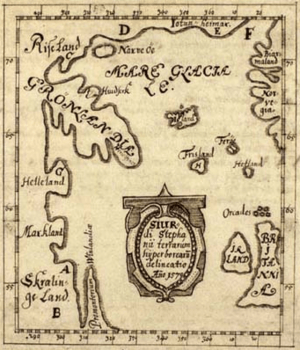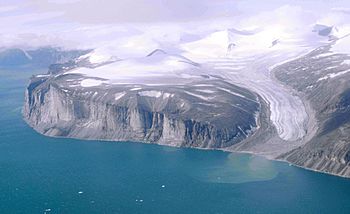Helluland facts for kids
Helluland was a name given to one of the lands discovered by Norse explorers in North America around 1000 AD. It was one of three main areas they found, the others being Vinland and Markland. Famous Viking explorers like Bjarni Herjólfsson, Leif Erikson, and Thorfinn Karlsefni visited these lands. Sometimes, all the land beyond Greenland was called Vinland, so Helluland might have been considered part of that larger area.
What Does Helluland Mean?

The name Helluland was given by Leif Erikson during his journey to Vinland. This happened according to the Saga of the Greenlanders. In the Old Norse language, "Helluland" means "Land of Flat Rocks" or "Land of Flat Stones." This name perfectly described the landscape the Vikings saw.
Helluland in the Viking Sagas
The sagas are ancient stories that tell us about the Viking voyages. They say Helluland was the first of three lands in North America that Erikson explored. He decided not to build a settlement there because the land seemed very difficult to live on. After exploring Helluland, he continued sailing south to Markland (which was probably Labrador) and then to Vinland (which might have been Newfoundland).
One saga, the Saga of Erik the Red, describes Helluland like this: "They sailed for two days and then found land. They explored it and found many large, flat stones. These stones were so big that two men could lie on them. There were also many polar foxes there. They named this land Helluland, meaning 'stone-land'."
Other sagas also mention Helluland. The Saga of Halfdan Eysteinsson talks about a hero named Ragnar who took control of Helluland's wild areas. Another old Icelandic story describes a hero named Örvar-Oddr tracking an enemy to the "Skuggifjord" (which might be Hudson Strait) in Helluland's uninhabited regions. These stories show that Helluland was seen as a distant and wild place.
Where is Helluland Today?

Most experts today agree that Helluland is what we now call Baffin Island. This island is located in the Nunavut territory of Canada. The description of Helluland in the sagas as a land of flat stones matches the landscape of Baffin Island.
The Norse explorers likely met the native people living there, who belonged to the Dorset culture. The sagas called these people skrælings. Historians believe that while the Vikings and the Dorset people met, their contact did not greatly change either culture.
A researcher named Patricia Sutherland found interesting clues about Viking presence on Baffin Island. She found yarn in museum collections that matched yarn from Norse settlements in Greenland. This made her look deeper into whether Vikings had lived on Baffin Island. Over several years, she found many artifacts at sites like Tanfield Valley. These included tally sticks, signs of iron and bronze metalwork, and whetstones used for sharpening metal tools. She also found European-style stone and turf buildings. These findings suggest that Vikings stayed on Baffin Island for a long time. They might have even traded with the native Dorset people.
Some experts, like James Tuck, agree that Sutherland's findings strongly suggest a Viking camp on Baffin Island. Sutherland and her team have identified several possible Viking sites. These include Tanfield Valley, Avayalik in northern Labrador Peninsula, Willows Island, and Pond Inlet in northern Baffin Island.
However, not all researchers agree. Michele Hayeur Smith, an expert in ancient textiles, believes that the Dorset and Thule people could spin yarn on their own. She thinks they didn't need to learn it from Europeans. Her research suggests that Arctic people were spinning threads from animal hair and sinews long before any Europeans arrived.
William W. Fitzhugh from the Smithsonian Institution also believes there isn't enough published proof to fully support Sutherland's claims. He points out that the Dorset people were already using spun cords by the 6th century.
Today, the only confirmed Viking site in North America outside of Greenland is L'Anse-aux-Meadows in Newfoundland. This site has eight sod buildings and artifacts found in the 1960s.
See also
 In Spanish: Helluland para niños
In Spanish: Helluland para niños

